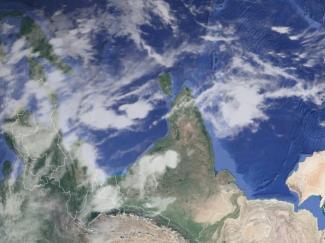The Problem Of OMZs: Indian Ocean Is Fast Loosing Oxygen!
Among the many problems confronting the oceans and seas such as climate change, global warming and sea level rise, a major issue of concern is the rapidly decreasing levels of oxygen present in the waters. The Intergovernmental Oceanographic Commission (IOC) of the United Nations Educational, Scientific and Cultural Organization (UNESCO) has cautioned that oxygen levels in the oceans, from the surface to the greatest depths, are worsening. This is due to indiscriminate discharge of pollutants, sewage, and industrial waste into the seas. Furthermore, excessive use of hydrocarbons, fossil fuels and biomass for power generation, industrial activities and household use have contributed to global warming.
The decrease in oxygen levels is particularly seen in tropical waters where the rate of loss of dissolved oxygen has gone up to 20 per cent. In addition, the oxygen minimum zones (OMZs) are expanding rapidly thereby impacting the survival of marine life that relies extensively on the dissolved oxygen for its existence and also affecting the bio-geochemical cycling of carbon and nitrogen, potentially aggravating global warming.
Geography of OMZs
The OMZs occur between 200 and 800 meters depth and only a few marine organisms can survive in this area. This is due to the fact that absence or low level of oxygen results in alteration in the nitrogen cycle thus “producing more nitrous oxide, which has a greenhouse effect roughly 300 times worse than carbon dioxide”.
There are a number of pockets across the oceans that have reached critical levels where ‘oxygen declines’ have been measured to be as low as <2 mg liter. OMZs have been observed at 300 m of depth and are prominent in the Pacific Ocean along the west coasts of the United States, Mexico and Latin America and in the Atlantic Ocean. Very small patch of OMZ is seen on the west coast of Africa. The biggest OMZ patch, however, is seen in the Indian Ocean - Arabian Sea and the Bay of Bengal.
Arabian Sea
A recent scientific study has concluded that the Gulf of Oman stretching 70,000 square mile is oxygen-starved and has been assessed as the world’s largest OMZ. Given that OMZs tend to expand, there are fears of an impending ecological disaster in the North Arabian Sea that will affect a number of countries such as Saudi Arabia, Oman, Iran, Pakistan, India, and those along the Persian Gulf. Although the region, in large parts, is known for its rich marine biodiversity and resources such as fish, shellfish, reptiles, mammals, birds, coral reefs, aquatic plants and mangroves, it may face a number of ecological challenges in the near future which could impact on the livelihoods of a large number of populations living in the coastal areas.
Bay of Bengal (BoB)
Similarly, an OMZ measuring 60,000 square kilometers, almost devoid of oxygen, has been discovered in the Bay of Bengal (BoB). A multinational study group from India, Denmark and Germany has concluded that the state of affairs in the Bay of Bengal is frightening. One scientist has warned that “should a similar global trend apply to the BoB, its OMZ will trip to anaerobic mode, like in the Arabian Sea.”
The northern Bay of Bengal receives loads of pollutants from rivers in Bangladesh, Myanmar and India. Among these, the Buriganga River in Bangladesh is perhaps the most polluted as every type of pollutant is found in it. Dhaka, the country’s capital, dumps nearly 4,500 tons of solid waste into the river daily and about 80 per cent of it is untreated. Scientists argue that “physical processes and the temperature-salinity structure in the BoB directly influence the OMZ and the depth of the oxycline and nutricline, thereby affecting the phytoplankton and marine mammal communities.”
Challenges and Solutions
A number of marine science studies have concluded that ocean’s capacity to produce oxygen will be reduced in the future due to ever-increasinganthropogenic pressures and human interference. Further, the number of OMZs across the globe is expected to increase and would probably worsen in estuaries, creeks and coastal areas. This will impact the fragile marine biodiversity and decrease the reproductive capacity of marine life affecting the complex food chain. Perhaps what is more worrisome is the fact that expanding OMZs will contribute to increase in greenhouse gas emissions and aggravate climate change. This will be compounded by growing human population, industrial growth in coastal areas, unsustainable material production, inefficient sanitation and waste management practices that will surely act together as multi-stressors and cause great distress to the delicate marine ecosystem.
The solution to OMZs lies on land and given that the oceans and seas are bordered by many countries, a collective approach to find a viable solution is critical. In the Arabian Sea, the India-Pakistan-Iran-Oman maritime crescent is surely going to witness the impact of OMZ and would require collective mechanism to study and draft strategies to address the problem.
Ironically, the dead zone in the Gulf of Oman could not be discovered earlier (last survey of the area was done in the 1990s) because of “the region’s political instability and the threat of ocean piracy”. One of the researchers of this marine scientific expedition has cautioned that dead zones at sea are a “real environmental problem, with dire consequences for humans, too, who rely on the oceans for food and employment.”
Unlike the Arabian Sea that does not have a regional mechanism in place, in the Bay of Bengal region there exists the Bay of Bengal Initiative for Multi-Sectoral Technical and Economic Cooperation (BIMSTEC), an international organization of seven nations of South Asia and South East Asia, which can be a good platform for addressing the OMZs related problems.
